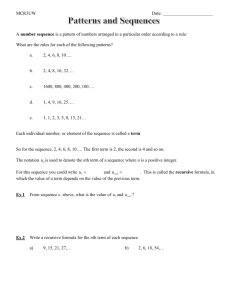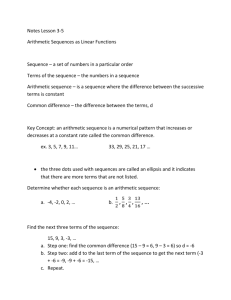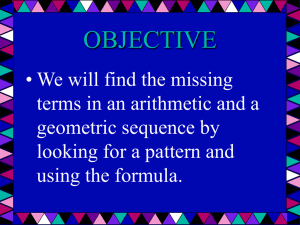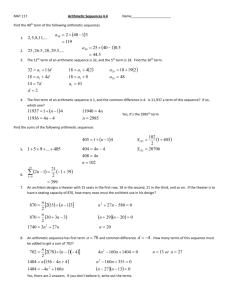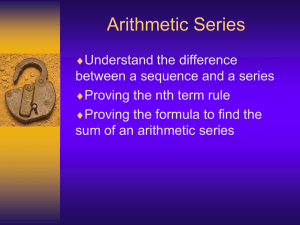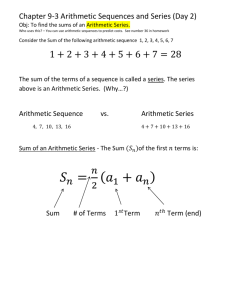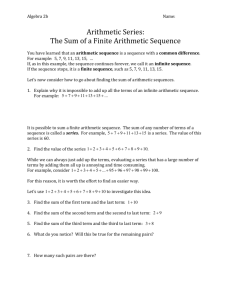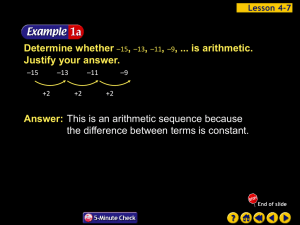Arithmetic_Sequences_as_Linear_Functions_(3.5)
advertisement
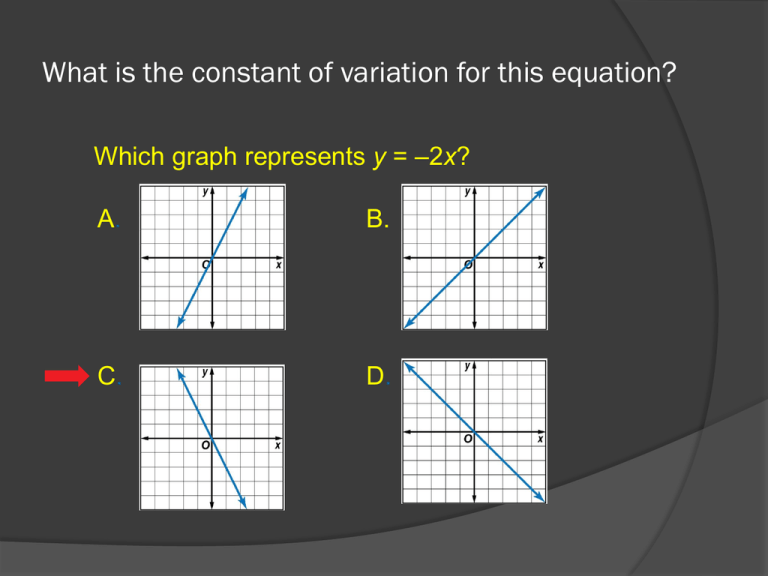
What is the constant of variation for this equation? Which graph represents y = –2x? A. B. C. D. "I hear, and I forget. I see, and I remember. I do, and I understand." ~~ Chinese Proverb Objective: Recognize arithmetic sequences. Relate arithmetic sequences to linear functions. CLE 3102.3.1; Use algebraic thinking to analyze and generalize patterns. SPI 3102.1.1; Interpret patterns found in sequences, tables, and other forms of quantitative information using variables or function notation. SPI 3102.3.1 Express a generalization of a pattern in various representations including algebraic and function notation. Sequence Set of numbers in a specific order Terms 7 12 17 22 27 Common Difference +5 Arithmetic Sequence Numerical Pattern that increases or decreases at a constant rate or value – Common Difference A. Determine whether 2, 4, 8, 10, 12, … is an arithmetic sequence. A. cannot be determined B. This is not an arithmetic sequence because the difference between terms is not constant. C. This is an arithmetic sequence because the difference between terms is constant. Find the Next Term Find the next three terms of the arithmetic sequence –8, –11, –14, –17, …. Find the common difference by subtracting successive terms. The common difference is –3. Subtract 3 from the last term of the sequence to get the next term in the sequence. Continue subtracting 3 until the next three terms are found. Answer: The next three terms are –20, –23, and –26. Terms 7 12 17 22 27 Common Difference +5 Write sequence as: 7, 7+5, 12+5 , a1, a1+d, a2+d, 7, 7+5, 7+5+5, 7, 7+1(5), 7+2(5), a1, a1+1d, a1+2d, 17+5, 22+5… a3+d, a4+d, …. 7+5+5+5, 7+5+5+5+5 7+3(5), 7+4(5) a1+3d, a1+4d, …. nth term = a1+(n-1)d Terms 7 12 17 22 27 Common Difference +5 Write sequence as: nth term = a1+(n-1)d Find 3rd Term n3 term = a1+(3-1)d n3 term = 7+(3-1) 5 = 7 + (2)5 = 7+10 =17 Terms 7 12 17 22 27 Common Difference +5 Linear Equation Y X Terms 9 17 25 33 Common Difference = +8 ? nth term = a1+(n-1)d Find 5rd Term n5 term = a1+(5-1)d n3 term = 9+(4) 8 = 9 +32 = 41 ? MONEY The arithmetic sequence 2, 7, 12, 17, 22, … represents the total number of pencils Claire has in her collection after she goes to her school store each week. A. Write an equation for the nth term of the sequence. A. an = 2n + 7 B. an = 5n + 2 C. an = 2n + 5 D. an = 5n – 3 MONEY The arithmetic sequence 2, 7, 12, 17, 22, … represents the total number of pencils Claire has in her collection after she goes to her school store each week. B. Find the 12th term in the sequence. A. 12 B. 57 C. 52 D. 62 MONEY The arithmetic sequence 2, 7, 12, 17, 22, … represents the total number of pencils Claire has in her collection after she goes to her school store each week. C. Which graph shows the first five terms of the sequence? A. B. Practice Assignment Page 191, 8 - 28 Even



